Documentation for Flash! 2.0.3
- Overview
- Views (forms)
- Dialogs
- Start Test Dialog
- Deck Details Dialog
- Clear Values Dialog
- Card Details Dialog
- Import Dialog
- Preferences Dialog
- Menus
- FAQ
- Creating and Sharing Decks
- How do I create a deck in Flash! and put in all the cards I need to study?
- How do I share a deck I have created with people?
- How do I get a deck ready to share with others?
- How can I merge two decks or copy a deck or a category from a deck?
- I love Flash!. How do I let others know what a great program it is? (Or, I hate Flash! and want to warn others).
- Registration/Update issues
- How do I install a new version of Flash!?
- Can I download a trial version?
- What do I get with registration?
- How will I get the registered version of your software? Will I receive a registration number or do you send out the registered version of the software to the consumers?
- I entered my password to register the program and it played a little happy tune but otherwise did nothing else. Does this mean that the registration process was successful?
- Working with other apps
- I'm using Flash! with Translate, and I can't seem to make the font change. How do I do this?
- How does Flash! know where to put the cards it imports from Translate?
- When I import decks that work fine in JTutor, instead of getting individual cards, I'm shown a first card that simply lists all the items in the deck. Suggestions?
- Testing Questions
- Is it possible to setup Flash! 1.3.0 so that I will be quizzed automatically at predetermined intervals?
- How can I tell when I have answered a question correctly in multiple choice mode?
- I just want to review all the questions and answers in order without "testing" myself on them. What should I do?
- How does Flash! get the different answer choices in multiple choice mode?
- In an honor system (non multiple-choice) test, what is that little box with the word "Very" next to it?
- Tell me more about the learning paradigm in Flash! and how it decides when to test you on any given card?
- What does the number in the learning delay in the card details dialog actually mean?
- I pressed OK on the start test dialog, and the dialog just flickered and showed right back up, without testing me on any questions. What does this mean?
- How do I run a test on multiple decks at once?
- Other Questions
- Feedback
Legal Stuff
Overview
| Basic principles | Flash! is a learning aid program for the palm pilot, based on the concept of flash cards. In Flash!, groups of cards are called decks. |
| The Card | A card has 2 main sides: question, symbolized by a "?" in the upper right, and answer, symbolized by a "!". You may also associate an optional note with each card. |
| Three Views | There are 3 main views in Flash!, which you can access using the three small buttons at the lower left. The list view is symbolized by a small house, or home; this is where you choose which deck to use and create or import decks. The edit view is symbolized by a small quill (feather). There are actually two types of edit view: the edit deck view, where you see a list of cards in the current deck, and the edit card view, where you edit the text on the various sides of an individual card. The test view is symbolized by a lightning bolt. This is where you test your knowledge and study your mistakes. |
| Two Types of Test | Flash! has two testing modes, learning and quiz. Quiz mode can give you a complete test of all the cards in a deck, or of only the hardest cards in a deck. The true beauty of Flash!, however, is in learning mode. This creates a personalized learning schedule for you, testing you on each card as you need to be reminded of that information. It does this by keeping track of the difficulty you have had with it in the past and how many tests it has been since you saw that card last. More about the learning paradigm |
| Suggested use | Research on learning suggests that
the learning schedule developed in Learning mode is superior to a simple
repetitive studying for an equivalent amount of time. This research can
also give you some pointers to get with Flash!.
|
| Power tip: Categories | Categories are a very powerful feature
in Flash!. Almost anything you can do with an entire deck, you can do with
a given category, including import from, import into, export to memopad,
clear card values, and run a test. Moreover, in multiple choice mode, the
answers are chosen from questions within the same category. If you prefer
to test yourself on several unrelated sets of questions at once, perhaps
you should make them separate categories within a deck rather than separate
decks.
(You can even delete all the cards in a given category by going to the deck list view (the house at lower left), choosing import deck, choosing other deck as the source, choosing the deck and category, and hitting "import and delete". You then have to delete the bogus deck by choosing it and going to delete deck from the deck menu.) |
| More help | In addition to this help file, Flash! has a limited amount of online context-based help, available from the (i) buttons at the top right corner of the various dialog boxes. |
^TOP^
 List
View
List
View
This shows the list of decks on your pilot. From
this view, you may edit a deck by tapping on its name, or create a new
deck by tapping new. Tapping on a deck will take you to one of the
other three views (edit card, edit
deck, or test) depending on how you last used that
deck.
^TOP^
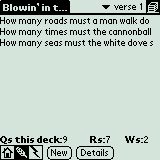 Edit
Deck View
Edit
Deck View
From this view, you may choose to go to the edit
card view by tapping on a card from the scrolling list of cards. This
also shows you some information about the deck: the total number of times
you have tested yourself with any card in the deck (including deleted cards),
and the total number of right and wrong answers you have had in that time.
The New button will create a new card (at the top of the deck) and take you to the edit card view to edit it. The Details button will take you to the deck details dialog.
The small highlighted deck in the upper left corner is merely an indicator that this is the edit deck view.
This view has a deck menu,
a limited card menu with only the new card
option, and an options menu.
^TOP^
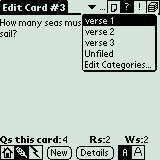 Edit
Card View
Edit
Card View
This view allows you to edit the contents of a card.
The field in which you edit is scrollable. Also, if you have scrolled to
one end of the field, you may use the scroll buttons again to switch sides
or cards as appropriate.
The current side of the current card is indicated in the upper right. The sides are (note icon): note. Notes you create here may be viewed in test mode as you desire; (?) Question: this represents one part of the fact you are memorizing, often in the form of a question; (!) Answer: the other part of the fact; (deck icon) return to edit deck view. You may also return to edit deck view by tapping the quill in the lower left.
Displayed in this view is the total number of times you have answered this question in a quiz, along with the number of times you got it right (Rs) and wrong (Ws).
Press the New button to create a new card (after the current one) and edit it. Press the Details button to go to the card details dialog. The two font size push buttons adjust the size; Flash! remembers the font size of the front and back of a card for future reference (edit and test) but does not remember the note font size.
This view has a deck menu,
a card menu, an typical edit menu, and an options
menu.
^TOP^
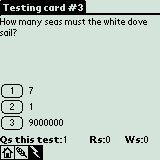 Test
View (multiple choice mode shown)
Test
View (multiple choice mode shown)
This view is where you actually test yourself. Before
a test starts, you will have to complete the start
test dialog. You can keep track of your progress through the test by
watching the one-pixel bar across the top, just below the title. This bar
grows from left to right as Flash! considers each card to see whether it
is time to quiz that knowledge.
In a multiple choice test: If an answer doesn't fit on one line and you need to see the full text before choosing it, just tap on the text of the answer; it will highlight and the full version will show up above, where the question goes. To see the question again, tap in the field where it goes.
When you've decided on an answer, simply press a button to choose that item. If you are wrong and the "wait after mult. choice" preference is set, the right answer will highlight itself for a brief pause or until you tap again before going to the next question.
In an honor system test, think of the correct answer. Then, tap on the main part of the screen to check your answer. Press right or wrong, depending on how you answered. If you were especially sure and/or could think of the answer especially easily, check the "very" checkbox before pressing the button; this helps Flash! develop your learning schedule.
Testing will produce sounds for right and wrong answers unless game sound is turned off in the system preferences app on your pilot.
This view has a deck menu and an options menu.
^TOP^
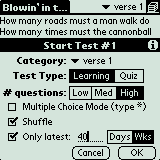 Start
Test Dialog
Start
Test Dialog
This dialog box is how you start a new test. The
basic purposes of the two test types are shown in the overview.
# questions is a relative term that depends on the test type, the number of cards in the deck, and your current level of progress. Since you can pause (or stop, depending on the "leaving test mode ends test" preference) a test at any time, you do not need this option if you only want to answer a few questions. It is mostly useful just to give you an idea of how much you should be studying; when the start test dialog comes up again, the test is done, and you can take a break. However, for a "quiz" type test, a low or medium number of questions will only ask you the questions that are harder than average for this deck.
Check the multiple choice mode checkbox
if you want a multiple choice test. It says "(type *)" merely to remind
you how multiple choice mode tests are displayed in the deck
details dialog. Uncheck the shuffle check box if for some reason
you want to quiz yourself in the order of the cards in the deck. Check
the only latest checkbox, and enter a number in the field that appears,
if you want to only test yourself on cards that have been created recently,
in the last n days or weeks.
Sometimes, the start test dialog won't go away when you press OK. Read
"empty tests" from the FAQ to learn why.
^TOP^
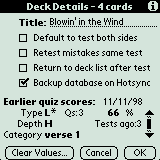 Deck
Details Dialog
Deck
Details Dialog
This is where you modify the details and the default
behavior of a given deck. It is also where you view your scores for current
or previous quizzes.
In the title field, you can edit the title of the current deck. 30 characters is the maximum. Press the "Default to test both sides" checkbox in order to have newly created cards have 'test both sides' checked in their card details dialog. (see that dialog for explanation of what that does) In order for this setting to affect already existing cards, you must use the clear values dialog. Press the "Retest mistakes same test" checkbox to test a given card more than once within a test until you get it right (cards retest right away if the shuffle checkbox was not checked in the start test dialog.) Press the "Return to deck list after test" checkbox if you are done editing this deck; then, when you finish a test, Flash! will return to the list view, and you can simply choose the deck again to start the next test. Press the "Backup database on Hotsync" to have the database automatically back up every hotsync. This protects your data but slows down hotsyncs.
Below these check boxes is an area which can display the results of your tests on this deck. It gives the date, type, depth, number of questions, and percentage right of a given test. You can choose which test to display (up to a maximum of 7 tests ago) using the scroll bar or the scroll buttons.
The clear values button takes you to the
clear values dialog.
^TOP^
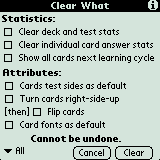 Clear
Values Dialog
Clear
Values Dialog
This is where you clear the statistics for a given
deck. It is accessible from both the deck details
and card details dialogs. Checking a box does
not clear those values until you press clear. Clearing deck and
test stats clears the statistics shown at the bottom of the edit
deck view and in the bottom part of the deck
details dialog. Clearing card answer stats clears the statistics
shown at the bottom of the edit card view. This
makes them show up often (as if they were unfamiliar) starting the next
time you are scheduled to see them. Show all cards schedules all
cards to show up the next time you do a learning-mode test. Cards test
sides as default sets the test sides checkbox in the card
details dialog of each individual card to equal the default to test
sides checkbox in the deck details dialog. Turn
cards right-side-up unchecks upside-down in each card's card
details dialog. [then] Flip cards toggles the upside-down checkbox
for each card. Happens after the right-side-up option if that is checked.
Thus, checking both would lead to all cards being upside-down. Set font
on all cards to sets the font in which all cards display to small or
large. If you do not choose a font here, cards are not changed. Note that
display font does not apply to multiple choice answers.
^TOP^
 Card
Details Dialog
Card
Details Dialog
This dialog shows the date this card was created.
Both sides vs. Upside-down
Imagine you created a card with Q='Why?' and A='Because'. If you checked both sides, sometimes tests would show you this card jeopardy-style; you would see 'Because', you would know that that was the answer by the fact that [A] was highlighted at upper right, and you would guess 'Why?' as the [Q].If instead you checked Upside-down, the two sides would actually switch, so that 'Because' would show up in ALL tests, with [Q] highlighted to let you know that this was in fact the question. Upside-down is mostly irrelevant if Both sides is checked, although it still affects display in the edit deck view. To flip again, uncheck Upside-down.
Clear or Change detail values or stats:
This card will let you clear the statistics of a card that show up at the bottom of the edit card view. This makes the card show up often (as if it were unfamiliar) starting the next time you are scheduled to see it. Next Shows lets you schedule a card to show next in the next learning-mode test, or to never show up until you set show next again. All CardsTakes you to the Clear values dialog to set the details of all cards at once.^TOP^
 Preferences
Dialog
Preferences
Dialog
The "Leaving test mode ends test" checkbox
determines whether leaving the test view (by switching to another view,
or by switching to another app) ends the current test, or simply pauses
it in progress.
If "Wait after mult choice answer" is checked, Flash! will pause after incorrect multiple choice answers to show you which answer was right. Tapping will end this approximately 1 second pause.
If "Keep Learning scores" is not checked, the scores for learning-mode tests, which can fluctuate meaninglessly, will be discarded when the test is complete; this allows for greater storage of quiz-mode scores.
If "Up=right; Down=wrong (btns)" (not shown in figure) is checked, then pressing the hardware scroll up button in a non-multiple-choice test is equivalent to pressing the "right" button.
If Show both Q+A in edit deck is checked, edit deck view is split down the middle, with questions on the left and answers on the right.
If the Sound box is not checked, there will be no sound. If it is checked, Flash! will play tunes if game sound is on in the preferences app that comes with your pilot; otherwise, it will play beeps if the system sound is on. If neither is on, the Sound checkbox here does nothing.
The default font is the font that all new cards and notes will display in. To change the font for existing cards, go to the clear values dialog.
^TOP^
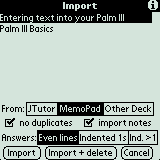 Import
Dialog
Import
Dialog
This presents a list of possible decks to import.
First choose the format from which to import (JTutor, MemoPad
or Other (Flash!) Deck. To import
decks from Brainforest or ThoughtMill, first export them to the memo pad,
then import them as a deck.)
(In the following discussion, "line" refers to the space between carriage returns, even if MemoPad normally wraps that onto several lines.)
If you choose MemoPad, further options apear. Check the Notes checkbox to interperet any line that starts with "<Note:" as a note. The note is considered to continue until the end of the line after the next ">" sign; thus multiline notes are possible. (This is the format in which Brainforest outputs notes).
The following three options tell you what should constitute an answer to be imported. Even lines means that every other line (excluding notes) should be an answer; the odd lines are questions.
Indented 1s means that the memo should be interpereted as an outline, either hand-made or as output from Brainforest or ThoughtMill. Each space or tab at the beginning of a line is counted as one level of indentation. Each item that has no children or siblings becomes an answer; its parent becomes a question. Ind. >1 does the same thing, except that groups of any number of siblings with no children become an answer, with their parent as the question.
Thus, if you had the following outline:
Types of BreakfastIndented 1s would create a card with question "Non-Vegetarian" and answer "Bacon", and one with question "Cold" and answer "Cereal". Ind. >1 would create the same cards, plus one with question "Vegetarian" and answer "Hash Browns<return>Scrambled Eggs".Hot
VegetarianColdHash BrownsNon-VegetarianScrambled Eggs
BaconCereal
If you import from an Other Deck (in order to merge two decks or copy a deck), you may choose whether to keep or discard the card Statistics and creation Dates of the imported cards.
Finally, after choosing a source to import from, press either Import or Import and Delete. Import and Delete deletes the database after importing from it; it is included for convenience but not recommended. The new cards go to the open database, if there is one; otherwise, a new database is created to hold them.
Note: There is a nice utility to convert text
files to JTutor decks, available from Land-J technologies (www.land-j.com).
Note that your registration for Flash! in no way registers you for any
Land-J product, and you are obligated to pay all applicable registration
fees on any Land-J product you use.
^TOP^
Deck Menu
- New deck creates a new deck and goes to the deck details dialog for that deck.
- Delete deck deletes the current deck after checking with a dialog.
- Deck details brings up the deck details dialog.
- End current test ends the current test if it is in progress or suspended. The next time you go to test view, you must first fill out the start test dialog.
- Goto testing performs the same function as pressing on the bolt icon in the lower left: it takes you to the test view.
-
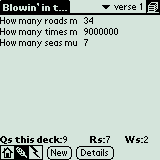 Sort
Deck: Sort cards alphabetically by question(?), answer(!), or note;
by date; or by percentage right in testing. Reverse sorts available.
Sort
Deck: Sort cards alphabetically by question(?), answer(!), or note;
by date; or by percentage right in testing. Reverse sorts available. - Import cards: Go to the import dialog. Cards imported are added to the current deck.
Export Deck to Memo: Export the current deck to the built-in MemoPad app.
^TOP^
Card Menu
- Delete Card deletes the current card.
- New Card makes a new card and goes to the edit card view.
Edit Other Side goes to the other side of the current card (? from ! or note; ! from ?).
^TOP^
Options Menu
- About Flash! shows you a dialog about Flash!
Preferences takes you to the preferences dialog.
^TOP^
Flash! Menu
The Flash! menu has the same items as the options menu, plus- Import Deck..., which takes you to the
import dialog to import an entire deck.
^TOP^
FAQ
Creating and Sharing Decks
How do I create a deck in Flash! and put in all the cards I need to study?
There are two ways to create a deck... from within Flash! on the pilot, or from elsewhere.To create a deck from within flash:
1. Hit "new" on the list view (the view with the house highlighted in lower left; press the house to get there) to create a deck.
2. Set the name of the deck and the preferences and hit OK.
3. You should now be in the Edit Deck view (quill highlighted in lower left; deck in upper right). Hit "new" to create a card.
4. You should be in the Edit Card view (The quill is highlighted in the view group at lower left; the question mark is in the side group at upper right). Enter the question (using graffitti or the on-screen keyboard available from the edit menu). To enter the answer to this question, first hit the exclamation point at upper right (the scroll down hardware button is a shortcut for this) and then enter the answer.
5. Hit "new" again to create a new card and repeat step 4.
To create a deck outside of flash, for instance using a word processor on your desktop computer:
1. In the word processor, type in the deck, with the first "line" being a question, then the corresponding answer, then a question, etc.; all even "lines" should be answers. Remember that 1 "line" in the word processor (perhaps you call them paragraphs) might wrap to look like several lines on your screen; it ends when and only when you hit return.
2. Select all, copy, go to pilot desktop, open the memopad, create a new memo, and paste.
3. Hotsync your pilot.
4. Go to the list view of Flash! and use the menu to "import deck..."
5. Choose memopad; choose the memo you just created; choose "even lines"; and hit "import".
How do I share a deck I have created with people?
If you have a deck that you think others would find useful, get it ready (see next question). You should now have a xxxx.pdb file for your deck.1)zip it, if you know how. Otherwise, that's fine, I'll do it.
2)Point your browser to ftp://homunculus.dragonfire.net/deck/ and drag the file onto your browser window. Click "OK" in the upload dialog. (Or, of course, use any anonymous FTP client.) The deck will not show up in your browser window, and you may get an error message somewhere about "@mozilla invalid", but you have now successfully uploaded the deck.
3)Write me email to tell me about this. I'll check that it isn't an evil virus and put a link on my deck sharing page.
How do I get a deck ready to share with others?
If you have the 'Backup Database' box checked in the deck details dialog for a deck, it will back itself up to a .pdb file in your pilot\<username>\backup folder on hotsync. This file can be installed on other pilots. ( There is an extra character at the beginning of the name of these files to ensure unique filenames.)The one problem, though, is that this file still has all the statistics of how well you have done in testing yourself. If you are just giving it to a friend, you can have them use the clear values dialog. However, if you intend to distribute your deck to a wider audience (for instance, by putting it on the web or uploading it to PilotGear H.Q. in one of their specialized topic categories such as 'medical'), you should clear the values before distribution. Here's how to clear the values without losing the statistics on your own pilot:
1. Go to the List View.
2. Choose "Import Deck" from the Flash! menu.
3. Choose "Other Deck" and uncheck "Statistics" and "Date"
4. Pick the deck you want to share. Remember the character that shows up before it and press "Import".
5. Tap on the newly created deck (moving you to edit deck view), tap on details, and make sure "Backup on hotsync" is checked.
6. Hotsync. In your pilot\<username>\backup folder on your computer's desktop is the file you want to share. It will have a different prefix character than the deck you imported from.
How can I merge two decks or copy a deck or a category from a deck?
In order to merge two existing decks, go into one of them, choose "Import cards..." from the deck menu, choose Other Deck, pick the deck to import from, and press "import". In order to copy a deck, do the same thing from the list view.Note that you can merge or copy just a single category from within a deck by choosing that category before you press "import". If you then press "import and delete" all the cards in that category will be deleted from the source deck.
I love Flash!. How do I let others know what a great program it is?
Post a review at www.eurocool.com.^TOP^ ^FAQ TOP^
Registration/Update issues
How do I install a new version of Flash!?
If you are installing version 2.0.x over a pre-2.0.x version (such as 2.0bx or 1.x.x) you will need to do a complete reinstall by the following procedure.1. Backup your decks (make sure that "backup on hotsync" is checked in the deck details dialog of each deck, then hotsync).
2. Delete Flash! from the launcher (choose delete from the app menu)
3. Install the new version of Flash!, as well as all your decks from the pilot/<yourname>/backup directory, using the palm install tool. Hotsync again to complete the installation.
4. You will need to re-enter your registration code.
However, if you are installing version 2.x over
version 2.0.x or later, you should *not* delete anything. Simply install
the new version; even your registration should remain in place.
Can I download a trial version?
The regular version works fine without registration. It just reminds you to register every so often.What do I get with registration?
You are registered for all versions of Flash!, now and in the future. Also, I usually answer questions from registered users, though I can't guarantee it. (And my turnaround is often under a day.)How will I get the registered version of your software? Will I receive a registration number or do you send out the registered version of the software to the consumers?
If you register via PilotGear or US mail, you will receive instructions on how to register the copy of Flash! that you already have. Registation options are explained/ linked to at homunculus.dragonfire.net/flash.htmlI entered my password to register the program and it played a little happy tune but otherwise did nothing else. Does this mean that the registration process was successful?
Yes.Working with other programs
I'm using Flash! with Translate, and I can't seem to make the font change. How do I do this?
First go to the preferences dialog from the menu and set the default font. Then, go to the clear values dialog (accessible from the deck details "clear values" button or the card details "all cards" button). Check "Card Fonts as Default" (last option) and hit "clear".How does Flash! know where to put the cards it imports from Translate?
The first time you export a card from a given language file in Translate, Flash! looks for a deck named after that language. If one exists, it puts the card there; if not, it makes one. From then on, it remembers to put words of that language into that deck, even if you change the name of the deck. However, if you soft-reset your pilot (by sticking a paper clip into the little hole in the back, or by a software crash, for instance), Flash! will forget its list of which deck is which, and go by name again. (If you want weird behaviour, you can actually use this as a feature. Soft reset, then rename your decks so they either do or do not get new words, then send a pair of words over to cement the connection. You can rename your decks again afterwards).When I import decks that work fine in JTutor, instead of getting individual cards, I'm shown a first card that simply lists all the items in the deck. Suggestions?
I doubt that this is actually what is happening. It sounds as if what you are seeing is the deck view, which is supposed to list all the cards. To see individual cards, you can either:1. Tap on a card to edit it; use the buttons at upper right to edit question/answer/note
2. Tap on the lightning bolt at lower left to be tested on all the cards.
^TOP^ ^FAQ TOP^
Testing Questions
Is it possible to set up Flash! 1.3.0 so that I will be quizzed automatically at predetermined intervals?
Not by itself. But since Flash! automatically goes to the most recent screen when it starts up, you should be able to get this functionality by combining Flash! with a program such as LookAtMe by Bill Ezell. I haven't tested this out - if you have any comments about how it works or how I could make it work better, please let me know.How can I tell when I have answered a question correctly in multiple choice mode?
You know by 3 cues:1. the correct answer stays highlighted a moment longer than the other two - more than a moment if "wait after mult. choice answer" is checked in the preferences dialog.
2. If "game sound" is on in the preferences app on your pilot, there is an audio cue.
3. The counts at the bottom of the screen ("Ws" and "Rs") keep track of how many right and wrong answers you have.
I just want to walk through all the questions and answers in order without "testing" myself on them. What should I do?
Go to the edit card view for the first card, and page through using the scroll down hardware button.How does Flash! get the different answer choices in multiple choice mode?
In order to keep decks small, the separate multiple choice answers come from different questions in the same category. If there are 6 or fewer cards in a category, it will choose answers from all categories.In other words, (assuming all cards mentioned
are in the same category) when the computer asks you question 5, the three
choices might be the answers to questions 17, 3, and 5. If you get this
question wrong by choosing the answer to question 3, Flash! remembers this,
and tries to trick you next time it asks question 5 by giving you the answers
to question 5, 3, and (for instance) 8 as options.
(I may improve this method in later versions.
However, I'm not too motivated to do so because, honestly speaking, most
people learn a lot more when they test themselves on the honor system.)
In an honor system (non multiple-choice) test, what is that little box with the word "Very" next to it?
Check this box when you were especially sure of the answer, and thus got the question "very right" or "very wrong". Flash! then realizes that you find this question especially easy/hard, and tests you with it less/more often in learning mode. The counts of how often you got it right and wrong shown at the bottom of the edit card view remain accurate.Tell me more about the learning paradigm in Flash! and how it decides when to test you on any given card?
First off, there's this reference. Flash! in no way attempts to reproduce exactly the conditions of the experiments described in this paper, however. Mainly, I saw this as the best reference to give for the idea that it improves learning to quiz with increasing intervals (i.e. intervals of 1-4-9 do better than 5-5-5) and that this holds whether the timescale of the units is minutes or days (other scale domains being less explored). One other result mentioned in passing in that study is the fact that a flash-card-type quiz is better than just a representation of a fact for stimulating recall.The main procedure in my code that implements this expanding-pattern is LTestNewTestsLeft, which takes both the recent and the overall history of right and wrong answers on a given question and derives the number of low-depth learning tests Flash! should wait before presenting that question again. (High-depth tests count as 4 low-depth ones). Essentially, this procedure goes through several steps:
1. derives the "adjusted right and wrong answer tallies" by adding the recent right or wrong answer numbers to the total numbers, weighted so that recent numbers and totals have approximately the same importance
2. Makes a quick approximation of 2 raised to the power of the ratio of right to wrong answers.
Note that this moves beyond the research in that it only expands the interval if you get the question right, actually contracting it for wrong answers. This is not directly supported by the paper I cited, but it is the advice of most "boost your memory"-type books and is also intuitively valid.
The exponential formula, the use of a ratio, and the equal weighting of recent and total numbers are really all my own developments. Although they fit broadly within the observed data, the fine-tuning of these and other minor details were mostly in order to get a system that "felt right" to me, where the program would not ask an easy question to the point of annoyingness or skip a question that I was beginning to forget.
What does the number in the learning delay in the card details dialog actually mean?
It is the delay (in number of low-depth learning tests; a high-depth test counts as 4 low-depth ones) before you next see that question. You may see it randomly up to 3 tests earlier. "Quiz" type tests do not use or affect this number. Thus, a low-depth learning test will show all questions with delay of under 2, and some with delay under 4. Medium, all under 3 and some under 5. High, all under 5 and some under 8.I pressed OK on the start test dialog, and the dialog just flickered and showed right back up, without testing me on any questions. What does this mean?
In learning mode, Flash! will only ask you questions with a low enough learning delay. This is so that, if you test yourself regularly, you will be reminded of a question exactly when you need reminding, and not sooner. Because of this, sometimes you will ask for a test, but Flash! will decide that you actually don't need to review any questions right now. When such an "empty test" happens, the start test dialog show right back up after you tap "OK". Notice that the "Start Test #X" at the top of the dialog will have gone up. If this number went up by more than one, that's the number of "empty tests" that were skipped. When this happens, you have two choices. If you're the kind of student who is always going for extra credit, you can go ahead and test yourself anyway, even though you don't really need it yet. Or, you can take a more laid back attitude, pat yourself on the back for the learning progress you've made, and take a break from studying for now.How do I run a test on multiple decks at once?
You can't currently do this. However, you can get much the same effect if you import your multiple decks into separate categories within a given deck.When you want to test yourself on one "deck" which is now only a category, choose that category from the Start Test dialog. When you want to test on all "decks", choose "All" instead.^TOP^ ^FAQ TOP^
Other Questions
Does Flash! have any easter eggs?
What do you think the Answer to that is? I know one thing that's not the answer, at least.I want to add graphics to cards in a deck. Is there a way to do this?
Not as of version 2.0.^TOP^ ^FAQ TOP^
Comments? Problems? Send to homunculus@kagi.com
Disclaimer: Although care has been taken to ensure a bug-free program, we will not be help responsible for any malfunctions as a result of the use of this program. PalmPilot is a registered trademark of 3Com incorporated, Land-J and JTutor may or may not be registered to Land-J technologies. This web page is intended for standalone use, and therefore if you are viewing it on my site you will be disappointed to find that the pictures do not make bizarre links.